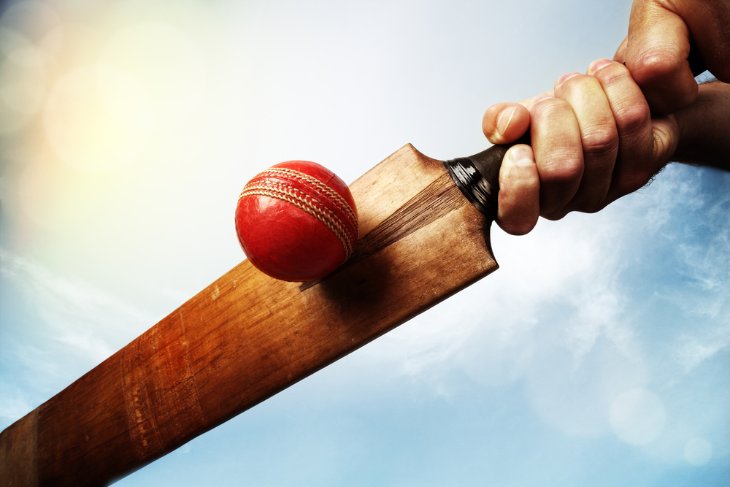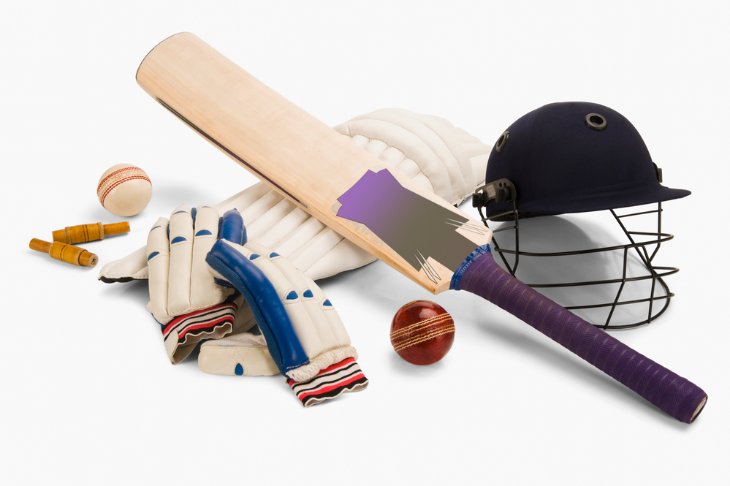Cricket is a captivating sport renowned for its elegant and strategic beauty. Its unique blend of individual skill and team coordination, especially in formats like Test and One-Day Internationals, makes it a mesmerizing spectacle. Cricket enjoys immense popularity in countries like India, England, and Australia, where it's more than just a sport; it's a cultural phenomenon that brings nations together. The game's elaborate traditions, passionate fan base, and moments of brilliance on the field contribute to its enduring charm, making cricket one of the most beloved and widely followed sports in the world.
If you are from these parts of the world, you probably know the rules very well. If not, this is the article for you, as it will give you a short explanation of how to play cricket. But, before we get on the rules, let’s take a look at the most basic equipment you’ll need to play this beautiful sport.

Cricket Equipment
If you want to learn how to play cricket, you have to learn about the essential equipment first. It consists of various items used by players to participate in the game safely and effectively. Here's an overview of the essential cricket equipment:
- Bat: The cricket bat is used by the batsman to hit the ball. It is usually made of wood, primarily willow, and has a flat striking surface on one side. Bats come in various sizes and weights to suit individual player preferences.
- Ball: The cricket ball is a hard, leather-covered sphere with a raised seam. It is used by the bowler to deliver deliveries to the batsman. The type of ball used can vary depending on the format of the game, with red balls typically used in Test matches and white balls in limited-overs formats like One-Day Internationals (ODIs) and Twenty20 (T20) matches.
- Stumps and Bails: Stumps are three vertical wooden posts that are driven into the ground at each end of the pitch. Bails are two small, wooden pieces that rest on top of the stumps. Together, they form the wicket, and the main objective of the bowler is to hit the stumps to dismiss the batsman.
- Wicketkeeper's Gear: The wicketkeeper wears protective gear, including gloves and leg pads, to safeguard against injury while standing behind the stumps. The wicketkeeper is responsible for catching balls, stumping batsmen, and ensuring the smooth running of the game.
- Pads: Batsmen wear leg pads to protect their legs from the impact of the ball. These pads are strapped to the legs and cover the shins and knees.
- Gloves: Batsmen wear gloves to protect their hands and provide a better grip on the bat. Cricket gloves are specially designed with padded palms to absorb the impact of fast deliveries.
- Helmet: Batsmen and wicketkeepers often wear helmets to protect their heads from fast deliveries. Helmets also have a grill to protect the face.
- Protective Gear: Players may also wear protective gear such as abdominal guards (box or cup) for male players and chest protectors for female players to protect sensitive areas from injury.
- Clothing: Cricket attire typically consists of a white shirt and trousers for Test matches, while limited-overs formats often involve colourful jerseys. Players also wear specialized cricket shoes with spikes for better grip on the pitch.
- Accessories: Some players use various accessories, such as forearm guards, thigh guards, and sweatbands, for added protection and comfort.
Basic Rules
Now that we have learned more about the equipment, let’s get on the basic rules, so you can learn how to play cricket:
- Teams: Cricket is played between two teams, with 11 players on each team.
- Toss: Before the game, a coin toss is held, and the winning captain decides whether to bat or bowl first.
- Batting: The team that bats first sends two players (batsmen) to the pitch. The aim of the batting team is to score as many runs as possible.
- Bowling: The opposing team's bowler tries to dismiss the batsmen by hitting the stumps with the ball or forcing them to make a mistake.
- Fielding: The fielding team tries to prevent the batting team from scoring runs by stopping the ball and returning it to the wicketkeeper or stumps.
- Runs: Batsmen score runs by hitting the ball and running between the stumps. They can also score runs by hitting the ball to the boundary, which is usually marked by a rope.
- Wickets: If a bowler hits the stumps and dislodges the bails, the batsman is out, and the next batsman comes in.
- Dismissals: Batsmen can be dismissed in various ways, including being bowled, caught, run out, stumped, or leg before wicket (LBW).
- Overs: The game is divided into "overs," with each over consisting of six deliveries (balls) bowled by one bowler.
- Innings: Each team has a turn to bat and bowl. An inning is completed when all 10 wickets of the batting team fall or when a predetermined number of overs are bowled.
- Winning: The team that scores the most runs wins the game. If the team batting second surpasses the score set by the first team, they win. If not, the first team wins.
Keep in mind that these are the basic rules of cricket, and there are many more nuances and variations depending on the format of the game (Test, One-Day International, or T20) and local rules. Cricket can be a complex sport to fully understand, but it's also very enjoyable to watch and play once you get the hang of it.
For further reading about the history of cricket rules, check our article: UK's Role in the Evolution of Cricket Rules.

More About Cricket Essentials
Pitch and Creases
If you want to learn how to play cricket, pitch and creases are things to start with. The cricket pitch is the central strip on the playing field, measuring 22 yards (20.12 meters) in length. It is where the main action of the game takes place, with one team's batsmen facing the other team's bowlers. The pitch is typically flat and made of compressed soil, clay, and grass. It must be well-maintained to provide a consistent playing surface for both batting and bowling.
The creases are markings on the pitch that serve as reference points for the players. There are several creases on the pitch, but the two most important ones are the popping crease and the bowling crease. The popping crease is marked 4 feet (1.22 meters) in front of the stumps and is the line that batsmen must not cross when running between the wickets. The bowling crease is the line from where the bowler delivers the ball, and it is located 8 feet 8 inches (2.64 meters) from the stumps at the bowler's end. The creases are crucial for determining whether a bowler has bowled a no-ball (if the foot crosses the crease) and for judging run-outs and stumping decisions (if a batsman is out of the crease behind the stumps). They play a central role in maintaining the integrity of the game's rules and ensuring fair play.
Scoring Runs
Scoring runs is the fundamental objective for the batting team in cricket. Runs are awarded when the batsmen successfully hit the ball and complete runs by running between the two sets of stumps at either end of the pitch. Each time they cross over and ground their bats beyond the crease, they score one run. Batsmen can continue running between the wickets as long as they believe they can do so safely. It's common for two or more runs to be scored in a single shot if the fielding team doesn't quickly retrieve the ball.
In addition to running between the wickets, batsmen can also score runs by hitting the ball to the boundary. If the ball crosses the boundary on the ground after being struck by the batsman's shot, it's worth four runs. However, if the ball clears the boundary in the air without touching the ground, it's called a "six," and the batting team is awarded six runs. Scoring boundaries is a key objective for batsmen as it allows them to accumulate runs quickly. The skill of placing the ball in gaps in the field and timing shots to find the boundary is a hallmark of top-notch batsmanship in cricket, and it's often accompanied by applause and excitement from the crowd.
Dismissals
A batsman can be dismissed in several ways:
- Bowled: If the bowler hits the stumps with the ball, and the bails fall off, the batsman is out.
- Caught: If a fielder catches the ball after it has touched the bat and before it hits the ground, the batsman is out.
- LBW (Leg Before Wicket): If the ball would have hit the stumps but instead hits the batsman's leg (without hitting the bat), and the umpire believes it would have gone on to hit the stumps, the batsman is out.
- Run Out: If the fielding team successfully breaks the stumps with the ball while the batsmen are attempting a run, the batsman running to the other end is out.
- Stumped: If the wicketkeeper removes the bails with the ball while the batsman is out of the crease and not attempting a shot, the batsman is out.
- Hit Wicket: If the batsman accidentally dislodges the bails with their bat or body while attempting a shot, they are out.
- Handled the Ball: If a batsman intentionally touches the ball with their hand without the permission of the fielding side, they are out.
No-Ball and Wide
In cricket, a "no-ball" and a "wide" are both types of illegal deliveries bowled by the bowler, and they result in the batting team receiving extra runs.
A "no-ball" occurs when the bowler oversteps the crease (the line behind which the bowler must start their delivery). It's called a no-ball because it doesn't count as a legitimate delivery, and the batsman cannot be dismissed off a no-ball unless they are run out. When a no-ball is bowled, the batting team is awarded one extra run, and the batsman has a free hit on the next delivery, meaning they can only be dismissed through a run-out, obstructing the field, or a hit wicket.
A "wide" is a delivery that is considered too wide for the batsman for them to have a reasonable opportunity to hit it. It is typically judged by the position of the batsman and where the ball passes relative to them. If the ball is too wide, it is called a wide, and the batting team is awarded one extra run. Additionally, the delivery is not counted as a legal delivery, so the bowler must bowl an extra delivery to make up for it. Wides can also be called for deliveries that pass too high above the batsman's shoulders, known as "wide of the crease," and for deliveries that bounce on the pitch outside the line of the stumps. Widely bowled deliveries are often seen as gifts to the batting side, as they provide an opportunity to score without any risk to the batsman.
Over
An "over" in cricket is a set of six legal deliveries bowled consecutively by one bowler from one end of the pitch to the batsman at the other end. It's a fundamental unit of measurement in the game and plays a pivotal role in regulating the pace and rhythm of a match. After each over, the responsibility of bowling shifts to another bowler from the same team.
The strategic use of bowlers and their allocation of overs is a critical aspect of team management, as different bowlers may specialize in various types of deliveries, such as pace bowling, spin bowling, or swing bowling, and can exploit different conditions and weaknesses of the opposing batsmen. Understanding the ebb and flow of the game often involves keeping track of how many overs have been bowled, how many remain, and which bowlers are yet to be used, all of which can influence team tactics and the eventual outcome of the match.
For further reading: What is an Over in Cricket?
Innings
In cricket, an "innings" represents a team's turn to either bat or bowl. The concept of innings is particularly significant in Test matches, the longest format of the game. In Test cricket, each team has two innings: one to bat and one to bowl. The team that wins the coin toss decides whether to bat or bowl first.
In limited-overs formats like One-Day Internationals (ODIs) and Twenty20 (T20) matches, each team has only one inning. In these formats, teams are typically restricted to a set number of overs (50 in ODIs and 20 in T20s), and they aim to maximize their runs while batting and limit the opposition's scoring while bowling. The concept of innings encapsulates the core structure of a cricket match, where teams take turns to compete, and it significantly influences the strategies and dynamics of the game based on the format being played.
Declaration
A "declaration" is a strategic move made by the batting team's captain in Test cricket. It involves voluntarily ending their team's batting inning before all their wickets have been dismissed. Declarations are typically made when the batting team believes they have accumulated a sufficient number of runs and wants to give their bowlers more time to bowl out the opposing team and secure a victory.
The decision to declare is influenced by several factors, including the total number of runs scored, the state of the pitch, the remaining time in the match, and the captain's assessment of their team's chances of winning. A well-timed declaration can put pressure on the opposing team, as they may have to chase a challenging target in a limited amount of time. However, it's a calculated risk, as declaring too early may allow the opposing team to escape with a draw or even win the match. The declaration is a strategic element that adds complexity to Test cricket and showcases the importance of captaincy and game awareness.
Follow-On
The "follow-on" is a rule that allows the team that bats first to impose a strategic advantage on the opposing team if they have a substantial lead after the first inning. Specifically, if the team batting first has a lead of 200 runs or more, they have the option to enforce the follow-on. This means they can require the opposing team to bat again immediately, without having to bat a second time themselves. The primary aim of enforcing the follow-on is to capitalize on their strong position, extend their lead, and increase the likelihood of winning the match by putting additional pressure on the opposing team's batsmen. However, it's a decision that requires careful consideration, as there's a risk that the opposing team could stage a comeback in their second inning, potentially resulting in a drawn or even lost match for the team enforcing the follow-on.
How to Play Cricket [Video] :
Summary
This would be a quick insight into the beautiful world of cricket. I hope you will find some parts of this article useful, that they will help you understand the rules better and give at least part of the answer on how to play cricket.


